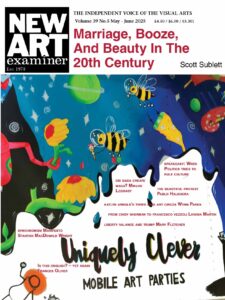
The Context of Creation

For the course of 20th century art the narrative of the art world has romanticized a particular set of variables in regards to the creative space of the artist. The picturesque idea of the high ceilinged loft/industrial space in which the artist creates has, over the past century, been instilled in both the general public and the institutional art world’s imaginations.
Driven in part through the cinematic portrayal of the working artist in film and codified in the Soho lofts of the 60s and 70s the idea that an artist must have a working space that is impressive, that is cavernous yet rough/industrial looking, has become a fetish within the art world. The size and style of your studio says as much about you as a creator as your work does to the average curator and dealer.
When they come to see your work they expect a kind of space that is pre-imagined, these romantic architectural notions instilled in their mind. If the space in which you work doesn’t live up to their imagination of what an artist’s space should be like they immediately lower their expectations of you and your work. In their minds the massive industrial loft is the de rigueur context in which an artist works, and anything less means inferiority and amateurism.
However a quick look at history shows that most of the historically important artists worked in a variety of spaces, from Turner’s extra bedroom, to Bacon’s South Kensington mews; Joseph Cornell’s basement workshop to Pollock’s unheated woodshed, spaces were as idiosyncratic as the artists themselves, often humble and cramped affairs.
When we look back even further, before the 20th century, we see that artists tended to work outdoors, either directly beside a studio structure, or entirely out in the natural world. This was due, in a practical sense, to both the lack of artificial lighting and the ventilation provided.
But working in the natural world, under the sun and clouds, feeling the breeze as one works, has an effect on the artist. As creators we become part of that natural world, our mood its mood, tempest to scorching, misty to chilling. Beyond the capacity of sunlight, when we are outdoors we are able to dig into who we are as creators in a way that can never be achieved inside the four walls of a studio. We become linked to some great other that guides our hand, that invites our gestures and movements, gives form and idea to our work.
Yet in the contemporary art world there is a contempt for anything that breaks the romantic notion of the artist as urban-dwelling, loft-living, industrial-space factory worker. An upturned nose or a listless bored look is all you will get out of the museum curator or name dealer who comes and sees your cramped studio bedroom, your garage space workshop, or your paint splattered garden.
As artists I think it is time we call bullshit on the studio loft. Overpriced romantic notions of ill lit real estate buffoonery have become impractical in the capitalist metropolises of the world. Our distance from the natural world as creators has led to a fatuous banality within the art world, reduced to well dressed shit throwing monkeys paying too much for a stage set on which rich collectors can project their fictitious narratives of what an artist is and where they work and live.
We must resist this notion, and return to the root of human creative practice – the natural world. We must find in the out-of-doors that very thing that drove the first humans to make marks on stones. We must become again a part of the world, and know again its capacity for both nurturing creation and violent destruction. If we are to find the edge of what we do as artists we must break free of our studio prisons, throw down our factory badges and go wandering lost in the wilderness once more.
Raymond Salvatore Harmon
Raymond Salvatore Harmon is an American painter, media theorist and artist living in London. His work straddles the boundary between the physical and digital realms of creative practice. raymondharmon.com
Volume 30 number 6, July / August 2016 pp 8-9

